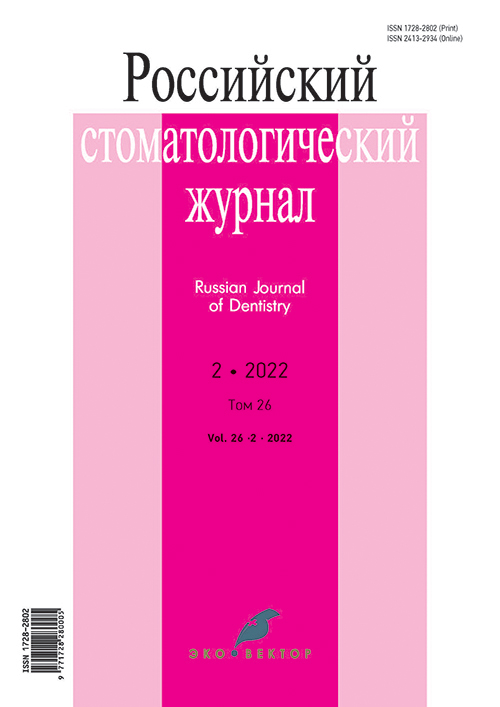Влияние скоростных режимов обжига образцов диоксида циркония из отечественных заготовок Ziceram T на показатели прочности и цветовые характеристики
- Авторы: Сахабиева Д.А.1, Деев М.С.1, Дьяконенко Е.Е.2, Поюровская И.Я.2, Русанов Ф.С.2, Лебеденко И.Ю.1,3
-
Учреждения:
- Российский университет дружбы народов
- Центральный научно-исследовательский институт стоматологии и челюстно-лицевой хирургии
- Выпуск: Том 26, № 2 (2022)
- Страницы: 95-102
- Раздел: Экспериментально-теоретические исследования
- URL: https://journals.rcsi.science/1728-2802/article/view/101409
- DOI: https://doi.org/10.17816/1728-2802-2022-26-2-95-102
- ID: 101409
Цитировать
Аннотация
Актуальность. В последние годы протезы из диоксида циркония постепенно становятся массовым видом ортопедического лечения. Налажен выпуск заготовок диоксида циркония для стоматологии и в нашей стране. В последние годы широко изучается возможность ускоренного обжига зубных протезов из диоксида циркония, позволяющая в 4–5 раз сократить процесс изготовления конструкций.
Цель исследования — изучить влияние скоростных режимов обжига на такие ключевые свойства, как прочностные характеристики при трехточечном изгибе и параметры цвета при 10 режимах ускоренной термообработки керамического материала, различных по скорости нагрева, конечной температуре и времени выдержки.
Материал и методы. В работе использованы образцы, полученные методом CAD/CAM-фрезерования из отечественных заготовок Ziceram T, цвет А2. В зависимости от режимов обжига образцы были распределены на 11 групп. Прочность спеченных образцов изучали при трехточечном изгибе на разрывной машине. Параметры цвета образцов определяли на цветоанализаторе «Спектрон-М» в системе CIE L*a*b на белом и черном фоне с помощью допустимых норм цветового различия и характеристик цветовых оттенков.
Результаты. По результатам испытаний на прочность при изгибе образцы имеют близкие значения — более 300 МПа. В соответствии со стандартом ISO 6872:2015 такая прочность при изгибе достаточна для изготовления одиночных коронок как в передней, так и в боковой группе зубов. Установлено повышение светлоты образцов керамики на основе диоксида циркония из отечественных заготовок Ziceram T фирмы «Циркон Керамика». Сокращенное время обжига приводит к повышению светлоты образцов, что связано со снижением их прозрачности.
Заключение. Экспресс-режимы обжига керамики на основе диоксида циркония Ziceram T гарантируют достижение необходимой прочности. При этом ни один из изученных режимов обжига не позволил достичь параметров цвета контрольных образцов.
Ключевые слова
Полный текст
Открыть статью на сайте журналаОб авторах
Джамиля Айдаровна Сахабиева
Российский университет дружбы народов
Автор, ответственный за переписку.
Email: djamilundel@ya.ru
ORCID iD: 0000-0003-1885-4269
Scopus Author ID: 57219431970
Россия, г. Москва
Михаил Сергеевич Деев
Российский университет дружбы народов
Email: deevms@mail.ru
ORCID iD: 0000-0002-1851-2982
канд. мед. наук, доцент
Россия, г. МоскваЕлена Евгеньевна Дьяконенко
Центральный научно-исследовательский институт стоматологии и челюстно-лицевой хирургии
Email: dikonen@mail.ru
ORCID iD: 0000-0002-8318-9966
Россия, г. Москва
Ирина Яковлевна Поюровская
Центральный научно-исследовательский институт стоматологии и челюстно-лицевой хирургии
Email: ipourov@yandex.ru
ORCID iD: 0000-0001-7108-3753
Россия, г. Москва
Федор Сергеевич Русанов
Центральный научно-исследовательский институт стоматологии и челюстно-лицевой хирургии
Email: fedor@yandex.ru
ORCID iD: 0000-0001-5280-0294
канд. мед. наук
Россия, г. МоскваИгорь Юльевич Лебеденко
Российский университет дружбы народов;
Email: lebedenkoi@mail.ru
ORCID iD: 0000-0002-4050-484X
д-р мед. наук, профессор
Россия, г. Москва; г. МоскваСписок литературы
- Cokic S., Vleugels J., Van Meerbeek B., et al. Mechanical properties, aging stability and translucency of speed-sintered zirconia for chairside restorations // Dent Mater. 2020. Vol. 36, N 7. P. 959–972. doi: 10.1016/j.dental.2020.04.026
- Kaizer M.R., Gierthmuehlen P.C., Dos Santos M.B., et al. Speed sintering translucent zirconia for chairside one-visit dental restorations: optical, mechanical, and wear characteristics // Ceram Int. 2017. Vol. 43, N 14. P. 10999–11005. doi: 10.1016/j.ceramint.2017.05.141
- Ersoy N.M., Aydogdu H.M., Degirmenci B.U., et al. The effects of sintering temperature and duration on the flexural strength and grain size of zirconia // Acta Biomater Odontol Scand. 2015. Vol. 1, N 2–4. P. 43–50. doi: 10.3109/23337931.2015.1068126
- Borrell A., Salvador M., Penaranda-Foix F., Cátala-Civera J. Microwave Sintering of Zirconia Materials: Mechanical and Microstructural Properties // Int J Appl Ceram Technol. 2012. Vol. 10, N 2. P. 313–320. doi: 10.1111/j.1744-7402.2011.02741.x
- Olevsky E., Kandukuri S., Froyen L. Consolidation enhancement in spark-plasma sintering: Impact of high heating rates // J Appl Phys. 2007. Vol. 102. P. 11491–11493. doi: 10.1063/1.2822189
- Almazdi A., Khajah H., Monaco E. Jr, Kim H. Applying microwave technology to sintering dental zirconia // J Prosthet Dent. 2012. Vol. 108, N 5. P. 304–309. doi: 10.1016/S0022-3913(12)60181-4
- Upadhyaya D.D., Ghosh A., Dey G.K., et al. Microwave sintering of zirconia ceramics // J Mater Sci. 2001. Vol. 36. P. 4707–4710. doi: 10.1023/A:1017966703650
- Luz J., Kaizer M., Ramos N., et al. Novel speed sintered zirconia by microwave technology // Dent Mater. 2021. Vol. 37, N 5. P. 875–878. doi: 10.1016/j.dental.2021.02.026
- Soult M.D., Lien W., Savett D.A., et al. Effect of high-speed sintering on the properties of a zirconia material // Gen Dent. 2019. Vol. 67, N 5. P. 30–34.
- Lee H.B., Lee T.H., Kim J.H. The effect of short and long duration sintering method on microstructure and flexural strength of zirconia // J Tech Dent. 2020. Vol. 42, N 2. P. 73–79. doi: 10.5109/1495025
- Lawson N., Maharishi A. Strength and translucency of zirconia after high-speed sintering // J Esthet Restor Dent. 2019. Vol. 32, N 2. P. 219–225. doi: 10.1111/jerd.12524
Дополнительные файлы









